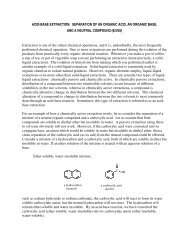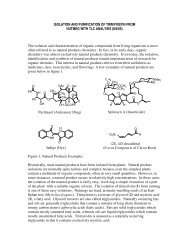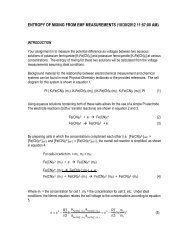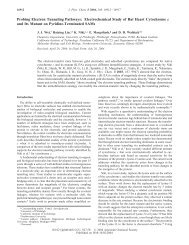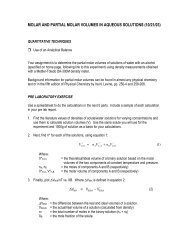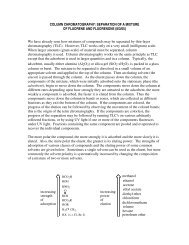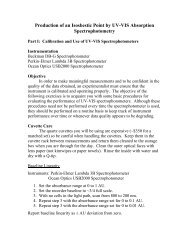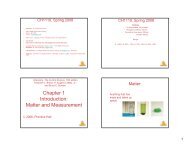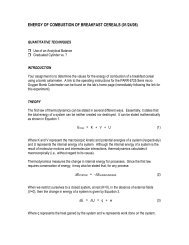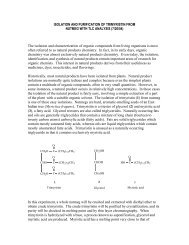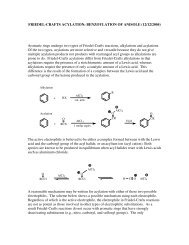Separation of Anthracene, Benzoic Acid, and p ... - Chemistry
Separation of Anthracene, Benzoic Acid, and p ... - Chemistry
Separation of Anthracene, Benzoic Acid, and p ... - Chemistry
Create successful ePaper yourself
Turn your PDF publications into a flip-book with our unique Google optimized e-Paper software.
ACID-BASE EXTRACTION: SEPARATION OF AN ORGANIC ACID, AN ORGANIC BASE,<br />
AND A NEUTRAL COMPOUND (5/27/09)<br />
Extraction is one <strong>of</strong> the oldest chemical operations, <strong>and</strong> it is, undoubtedly, the most frequently<br />
performed chemical operation. One or more extractions are performed during the isolation <strong>of</strong> the<br />
products from practically every organic chemical reaction. Whenever you make a pot <strong>of</strong> c<strong>of</strong>fee,<br />
a cup <strong>of</strong> tea, or pot <strong>of</strong> vegetable soup you are performing an extraction (more precisely, a solidliquid<br />
extraction). The isolation <strong>of</strong> trimyristin from nutmeg which you performed earlier is<br />
another example <strong>of</strong> a solid-liquid extraction. Solid-liquid extraction is commonly used by<br />
organic chemists to isolate natural products. However, organic chemists employ liquid-liquid<br />
extractions even more <strong>of</strong>ten than solid-liquid extractions. There are actually two types <strong>of</strong> liquidliquid<br />
extractions: chemically passive <strong>and</strong> chemically active. In chemically passive extractions,<br />
distribution <strong>of</strong> a compound between two immiscible solvents occurs because <strong>of</strong> different<br />
solubilities in the two solvents, whereas in chemically active extractions, a compound is<br />
chemically altered to change its distribution between the two different solvents. This chemical<br />
alteration <strong>of</strong> a compound to change its distribution between the two solvents is most commonly<br />
done through an acid-base reaction. Sometimes, this type <strong>of</strong> extraction is referred to as an acidbase<br />
extraction.<br />
For an example <strong>of</strong> how a chemically active extraction works, let us consider the separation <strong>of</strong> a<br />
mixture <strong>of</strong> a neutral organic compound <strong>and</strong> a carboxylic acid. Let us assume that both<br />
compounds are soluble in diethyl ether but insoluble in water. A passive extraction using these<br />
to solvents obviously will not work. However, if the carboxylic acid were converted into its<br />
conjugate base, an anion which would be soluble in water but insoluble in diethyl ether, then a<br />
clean separation <strong>of</strong> the carboxylic acid (as its salt) from the neutral compound could be effected.<br />
Consider a mixture <strong>of</strong> a hydrocarbon <strong>and</strong> a carboxylic acid, both <strong>of</strong> which are soluble in ether<br />
but insoluble in water. If an ether solution <strong>of</strong> the mixture is treated with an aqueous solution <strong>of</strong> a<br />
base,<br />
Ether-soluble, water-insoluble mixture:<br />
O<br />
C OH<br />
a hydrocarbon<br />
(neutral)<br />
a carboxylic acid<br />
(acidic)<br />
such as sodium hydroxide or sodium carbonate, the carboxylic acid will react to form its water<br />
soluble carboxylate anion, but the neutral hydrocarbon will not react. The hydrocarbon will<br />
remain ether-soluble <strong>and</strong> water-insoluble. By an acid-base reaction, we have converted the<br />
carboxylic acid (ether-soluble, water-insoluble) into its carboxylate anion (ether-insoluble,<br />
water-soluble).
Formation <strong>of</strong> a water-soluble salt:<br />
O<br />
O<br />
C<br />
OH<br />
+ OH<br />
C<br />
O<br />
+ H 2 O<br />
ether-soluble<br />
water-insoluble<br />
ether-insoluble<br />
water-soluble<br />
By extraction <strong>of</strong> an ether solution containing a neutral compound <strong>and</strong> a carboxylic acid with an<br />
aqueous solution <strong>of</strong> sodium hydroxide, we can separate the two compounds. The neutral<br />
compound remains in the ether layer, while the carboxylic acid reacts with hydroxide ion to form<br />
the carboxylate anion, which dissolves in the water layer. The two layers are separated using a<br />
separatory funnel, <strong>and</strong> the aqueous layer is then acidified to regenerate the water-insoluble<br />
carboxylic acid.<br />
Recovery <strong>of</strong> the carboxylic acid:<br />
O<br />
C O<br />
+ H<br />
O<br />
C<br />
OH<br />
carboxylate anion<br />
carboxylic acid<br />
Using a similar acid-base reaction, amines (organic bases) can be separated from neutral or<br />
acidic compounds by conversion into their conjugate acids, water-soluble cations. Thus<br />
treatment <strong>of</strong> an ether solution <strong>of</strong> a mixture containing an amine with an aqueous acid (e.g.,<br />
hydrochloric acid) produces a water-soluble cation that can be separated from water-insoluble<br />
compounds.<br />
Formation <strong>of</strong> a water-soluble salt:<br />
RNH 2 + H RNH 3<br />
ether-soluble<br />
water-insoluble<br />
ether-insoluble<br />
water-soluble<br />
After separation <strong>of</strong> the ether <strong>and</strong> water layers, the water layer is then treated with aqueous base<br />
to regenerate the water-insoluble amine.
Recovery <strong>of</strong> the amine:<br />
RNH 3 + OH RNH 2 + H 2 O<br />
ammonium cation<br />
amine<br />
Because different conditions are used to convert acidic <strong>and</strong> basic organic compounds into watersoluble<br />
salts, the acid-base reactions we have discussed can be used to effect a number <strong>of</strong> types<br />
<strong>of</strong> chemically active extractions. The flow chart that follows outlines the steps involved in the<br />
separation <strong>of</strong> an organic acid (RCO 2 H), an organic base (RNH 2 ), <strong>and</strong> a neutral compound (RH)<br />
by acid-base extractions.
Solution <strong>of</strong> RCO 2 H, RNH 2 , <strong>and</strong> RH in Organic Solvent<br />
Extract with<br />
dilute NaOH<br />
Aqueous layer<br />
RCO 2<br />
-<br />
Organic Layer<br />
RNH 2 <strong>and</strong> RH<br />
Make acidic, filter or<br />
extract with solvent<br />
Extract<br />
with dilute<br />
HCL<br />
Aqueous<br />
layer<br />
RNH 3<br />
+<br />
Solid or<br />
solution <strong>of</strong><br />
RCO 2 H<br />
Aqueous<br />
layer<br />
Make basic,<br />
filter or extract<br />
with solvent<br />
Organic<br />
layer RH<br />
Remove<br />
solvent<br />
discard<br />
RCO 2 H<br />
Aqueous<br />
layer<br />
Solid or<br />
solution <strong>of</strong><br />
RNH 2<br />
Remove<br />
Solvent<br />
discard<br />
Remove<br />
solvent<br />
RH<br />
RNH 2
In this experiment, a mixture comprised <strong>of</strong> 0.5 g each <strong>of</strong> benzoic acid, p-nitroaniline, <strong>and</strong><br />
anthracene will be separated into the individual components by acid-base extractions. All three<br />
components are soluble in dichloromethane (CH 2 Cl 2 ) but only slightly soluble in cold water.<br />
Procedure<br />
CO 2 H NH 2<br />
O 2 N<br />
benzoic acid p-nitroaniline anthracene<br />
Obtain 1.5 g <strong>of</strong> a 1:1:1 mixture <strong>of</strong> benzoic acid, p-nitroaniline, <strong>and</strong> anthracene <strong>and</strong> dissolve it in<br />
40 mL <strong>of</strong> dichloromethane in an Erlenmeyer flask. Pour this solution into a separatory funnel<br />
which has a teflon stopcock. (Use the addition funnel from your organic kit if necessary.) If<br />
small amounts <strong>of</strong> solid material do not dissolve, the solution should be gravity-filtered through a<br />
small cotton plug into the separatory funnel. Extract the organic solution with 25 mL <strong>of</strong> 2M<br />
sodium hydroxide solution. Separate the layers <strong>and</strong> extract the organic layer with a second 25<br />
mL <strong>of</strong> 2M sodium hydroxide. Combine the basic extracts in an Erlenmeyer flask <strong>and</strong> label the<br />
flask "basic extract".<br />
Now similarly extract the organic layer twice with 25 mL portions <strong>of</strong> 6M hydrochloric acid.<br />
Combine the acidic extracts in a second Erlenmeyer flask <strong>and</strong> label the flask "acidic extract".<br />
Transfer the organic layer into a third Erlenmeyer flask <strong>and</strong> label the flask "neutral fraction".<br />
Add approximately 2-3 g <strong>of</strong> anhydrous sodium sulfate to this neutral fraction, swirl <strong>and</strong> let st<strong>and</strong><br />
for at least 15 minutes with occasional swirling to hasten the drying.<br />
Cool the flasks containing the "acidic extract" <strong>and</strong> the "basic extract" in an ice-water bath.<br />
Neutralize the "acidic extract" by carefully adding 6M sodium hydroxide until the solution is<br />
distinctly basic to pH paper. Similarly, neutralize the "basic extract" by carefully adding<br />
concentrated (12M) hydrochloric acid until the solution is distinctly acidic to pH paper.<br />
Precipitates should form in each flask upon neutralization. The neutralizations will liberate<br />
considerable amounts <strong>of</strong> heat, so let the flasks st<strong>and</strong> in the ice-water bath until their contents are<br />
at, or below, room temperature.<br />
Collect each precipitate by vacuum filtration using a Buchner funnel <strong>and</strong> wash the filter cakes<br />
with a small amount <strong>of</strong> cold distilled water. Allow the collected solids to air-dry until the next<br />
laboratory period.<br />
Decant the "neutral fraction" from the sodium sulfate into a tared round-bottomed flask (the flask<br />
should be <strong>of</strong> sufficient size such that it will be no more than half-filled by the solution). Rinse<br />
the Erlenmeyer flask <strong>and</strong> the sodium sulfate with a small amount <strong>of</strong> dichloromethane, decanting<br />
it into the round-bottomed flask. Remove the solvent on a rotary evaporator. Reweigh the flask
with its contents, determine the weight <strong>of</strong> the neutral material, <strong>and</strong> calculate a percent recovery.<br />
Transfer this neutral material to a labelled vial <strong>and</strong> store it until the next laboratory period.<br />
NEXT LAB<br />
After the base (p-nitroaniline) is dry, transfer it to labelled <strong>and</strong> tared vial. Reweigh the vial to<br />
determine the weight <strong>of</strong> the solid <strong>and</strong> calculate it’s percent recovery. After benzoic acid is dry,<br />
transfer it to a tared flask. Reweigh the flask to determine the weight <strong>of</strong> the solid <strong>and</strong> calculate<br />
it’s percent recovery.<br />
Recrystallize benzoic acid from a minimum amount <strong>of</strong> hot water. (Use the solubility data to<br />
calculate the approximate amount below, based on the grams you recovered.) Add an extra 2-5<br />
mLs <strong>of</strong> hot water if there is still solid present after adding the minimum amount <strong>of</strong> solvent. If<br />
this does not dissolve the solid, you will need to perform a hot filtration (perform over a steam<br />
bath, use a small plug <strong>of</strong> cotton). Before cooling, heat on a hot plate to remove the extra solvent<br />
added prior to the hot filtration (if performed).<br />
Dry <strong>and</strong> weigh the crystals. Determine melting points for benzoic acid <strong>and</strong> p-nitroaniline <strong>and</strong><br />
compare them to literature values. Separately, dissolve a small amount <strong>of</strong> each <strong>of</strong> the three<br />
compounds in chlor<strong>of</strong>orm <strong>and</strong> spot a silica gel TLC plate with these solutions. Develop the TLC<br />
plate using chlor<strong>of</strong>orm. Visualize the spots under both short <strong>and</strong> long wavelength UV light <strong>and</strong><br />
record your observations.<br />
Please help conserve ice. Share with your bench partner when possible!<br />
Flush aqueous solutions down the sink w/ plenty <strong>of</strong> running water. Sodium hydroxide,<br />
hydrochloric acid are both aqueous.<br />
Write out the reactions for the extraction (e.g., C 6 H 5 -COOH + NaOH C 6 H 5 -COO - Na + +<br />
H 2 O) <strong>and</strong> think about the difference in solubility between the acid <strong>and</strong> base compounds vs.<br />
their salt forms.<br />
Before lab, calculate the moles <strong>of</strong> benzoic acid <strong>and</strong> 2M NaOH you will use to extract it with.<br />
Then calculate the amount <strong>of</strong> concentrated (12M) HCl it will take to neutralize it. Include<br />
these amounts in the reagent table <strong>of</strong> your pre lab. Do likewise for p-nitroaniline!<br />
The melting points <strong>of</strong> benzoic acid <strong>and</strong> p-nitroaniline are important physical constants for<br />
this experiment (<strong>and</strong> therefore belong in the reagent table <strong>of</strong> your prelab)!<br />
Read all applicable techniques in your lab text (Zubrick) <strong>and</strong> otherwise prepare well for this<br />
lab experiment!
SOLUBILITY DATA<br />
COMPOUND TEMPERATURE SOLUBILITY IN WATER<br />
(g/100mL)<br />
<strong>Benzoic</strong> <strong>Acid</strong><br />
p-Nitroaniline<br />
0 ºC 0.17<br />
20 ºC 0.29<br />
90 ºC 4.55<br />
0 ºC 0.08<br />
100 ºC 2.22<br />
<strong>Anthracene</strong> 78 ºC 1.49 (IN ETHANOL)
Name:_____________________________________________Section:___________Date:___________<br />
POSTLAB EXERCISE<br />
ACID-BASE EXTRACTION: SEPARATION OF AN ORGANIC ACID, AN ORGANIC BASE,<br />
AND A NEUTRAL COMPOUND (6/5/09)<br />
>> Due the lab following the completion <strong>of</strong> the experimental protion <strong>of</strong> the notebook (30pts.<br />
TOTAL). Please answer questions on this form.
2. (2pts) Explain how benzoic acid was recoved from extracted solution:<br />
How was p-nitroaniline recovered<br />
3. (2pts) The percent recovery for benzoic acid is usually lower than the percent recovery for p-<br />
nitroaniline. Comparing percent recoveries before purification, explain why this is true:<br />
Which compound had the highest recovery<br />
4. (2pts) How was benzoic acid purified<br />
5. (2pts) Which compound showed the largest R f value<br />
Which compound showed the smallest R f value<br />
Which compound fluoresced under longwave UV light<br />
6. (2pt) On the basis <strong>of</strong> what you have learned in this experiment, plus the information that<br />
phenol is soluble in aqueous NaOH but not in aqueous NaHCO 3 , whereas benzoic acid is<br />
soluble in both, draw a flow diagram showing how you would separate a mixture <strong>of</strong> benzoic<br />
acid, phenol, <strong>and</strong> aniline <strong>and</strong> attach it to this exercise.<br />
7. (3pts) The pK a <strong>of</strong> benzoic acid is 4.19. Explain whether or not precipitation <strong>of</strong> benzoic acid<br />
from an aqueous solution <strong>of</strong> benzoate anion would be complete if hydrochloric acid is added<br />
until a pH <strong>of</strong> 7 is obtained.



